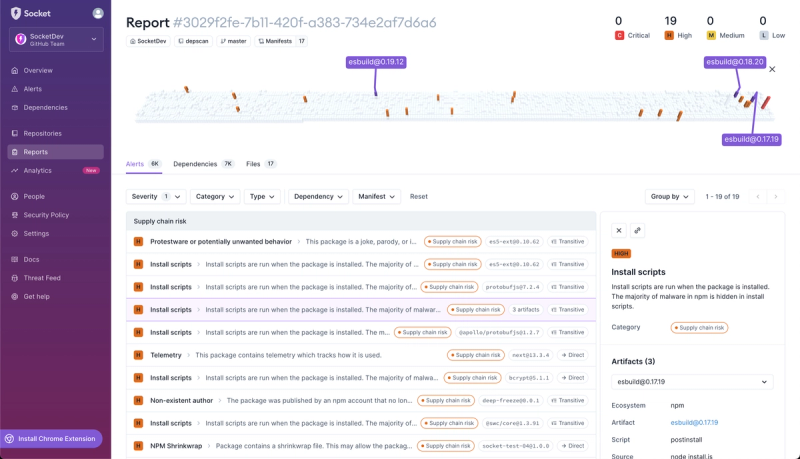
Company News
Connect with Socket at RSA and BSidesSF 2024
Come meet the Socket team at BSidesSF and RSA! We're sponsoring several fun networking events and we would love to see you there.
yocto-queue
Advanced tools
Weekly downloads
Package description
The yocto-queue npm package is a minimalistic queue with an array-like interface. It is designed to be a tiny, performant FIFO (First In, First Out) queue implementation for managing a list of items in a sequential order.
Enqueue
Adds elements to the end of the queue.
const Queue = require('yocto-queue');
const queue = new Queue();
queue.enqueue('unicorn');
queue.enqueue('rainbow');Dequeue
Removes and returns the first element from the queue.
const Queue = require('yocto-queue');
const queue = new Queue();
queue.enqueue('unicorn');
queue.enqueue('rainbow');
const firstItem = queue.dequeue();Clear
Clears the queue.
const Queue = require('yocto-queue');
const queue = new Queue();
queue.enqueue('unicorn');
queue.enqueue('rainbow');
queue.clear();Size
Returns the number of elements in the queue.
const Queue = require('yocto-queue');
const queue = new Queue();
queue.enqueue('unicorn');
queue.enqueue('rainbow');
const size = queue.size;Peek
Returns the first element in the queue without removing it.
const Queue = require('yocto-queue');
const queue = new Queue();
queue.enqueue('unicorn');
queue.enqueue('rainbow');
const firstItem = queue.peek();A promise queue with concurrency control, useful for rate-limiting asynchronous (Promise-returning) functions. It is more feature-rich than yocto-queue, offering concurrency control, task prioritization, and more.
A fast, in-memory work queue. This package is similar to yocto-queue but is tailored for asynchronous task processing and supports worker functions and concurrency.
A simple, fast, robust job/task queue for Node.js, backed by Redis. It is designed for high-performance and reliability, and it is more complex than yocto-queue, supporting job events, retries, and more.
A powerful rate limiter that makes throttling easy. This package is more advanced than yocto-queue, providing features like clustering, Redis support, and priority jobs.
Part of the async utility module, async.queue provides a queue implementation that works with asynchronous tasks. It is more versatile than yocto-queue, as it can handle concurrency and has a callback interface.
Readme
Tiny queue data structure
You should use this package instead of an array if you do a lot of Array#push() and Array#shift() on large arrays, since Array#shift() has linear time complexity O(n) while Queue#dequeue() has constant time complexity O(1). That makes a huge difference for large arrays.
A queue is an ordered list of elements where an element is inserted at the end of the queue and is removed from the front of the queue. A queue works based on the first-in, first-out (FIFO) principle.
$ npm install yocto-queue
import Queue from 'yocto-queue';
const queue = new Queue();
queue.enqueue('🦄');
queue.enqueue('🌈');
console.log(queue.size);
//=> 2
console.log(...queue);
//=> '🦄 🌈'
console.log(queue.dequeue());
//=> '🦄'
console.log(queue.dequeue());
//=> '🌈'
queue = new Queue()The instance is an Iterable, which means you can iterate over the queue front to back with a “for…of” loop, or use spreading to convert the queue to an array. Don't do this unless you really need to though, since it's slow.
.enqueue(value)Add a value to the queue.
.dequeue()Remove the next value in the queue.
Returns the removed value or undefined if the queue is empty.
.clear()Clear the queue.
.sizeThe size of the queue.
FAQs
Tiny queue data structure
The npm package yocto-queue receives a total of 36,171,804 weekly downloads. As such, yocto-queue popularity was classified as popular.
We found that yocto-queue demonstrated a not healthy version release cadence and project activity because the last version was released a year ago. It has 1 open source maintainer collaborating on the project.
Did you know?

Socket for GitHub automatically highlights issues in each pull request and monitors the health of all your open source dependencies. Discover the contents of your packages and block harmful activity before you install or update your dependencies.

Company News
Come meet the Socket team at BSidesSF and RSA! We're sponsoring several fun networking events and we would love to see you there.

Security News
OSI is starting a conversation aimed at removing the excuse of the SaaS loophole for companies navigating licensing and the complexities of doing business with open source.

Product
We're introducing dependency visualization for reports - get a quick impression of the state of your dependencies without getting lost in the details.